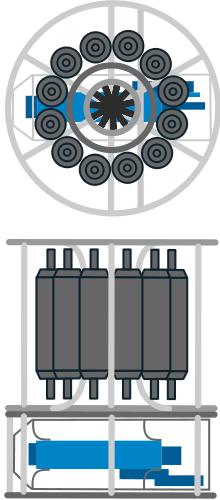Rosette sampler


A rosette sampler is a device used for water sampling in deep water (such as the Great Lakes or oceans) in order to investigate about its quality.
Description
A rosette sampler is made of an assembly of 12 to 36 sampling bottles.[1] Each bottle is a volume that range from a minimum value of 1.2 L to a maximum value of 30 L.[1] All of them constitutes the rosette sampler and are clustered around a cylinder situated in the center of the assembly,[1] where there is a sensing system called Sea-Bird or CTD, that stands for "Conductivity, Temperature and Depth", although other variables can be measured by modern CTDs (e.g. water turbidity, dissolved oxygen concentration, chlorophyll concentration and pH).[2]
The apparatus is attached to a wire rope. A winch on board of the boat unroll the rope during descent and roll up it during the ascent (i.e. at the end of the samples collection). During operations in the ocean, a rosette sampler can approach the seabed at a distance from 1 to 5 m, depending on the particular sea conditions.[3]
The opening of each sampling bottle can be automatic (by reaching a certain depth) or manual (by operator, remotely).[2]
Applications
Water sampling is used in general for chemical analysis and ecotoxicological assessment.[3]
A rosette sampler is preferred to Winchester sampler for collection of water sampling at depths greater than 50 m.[3]